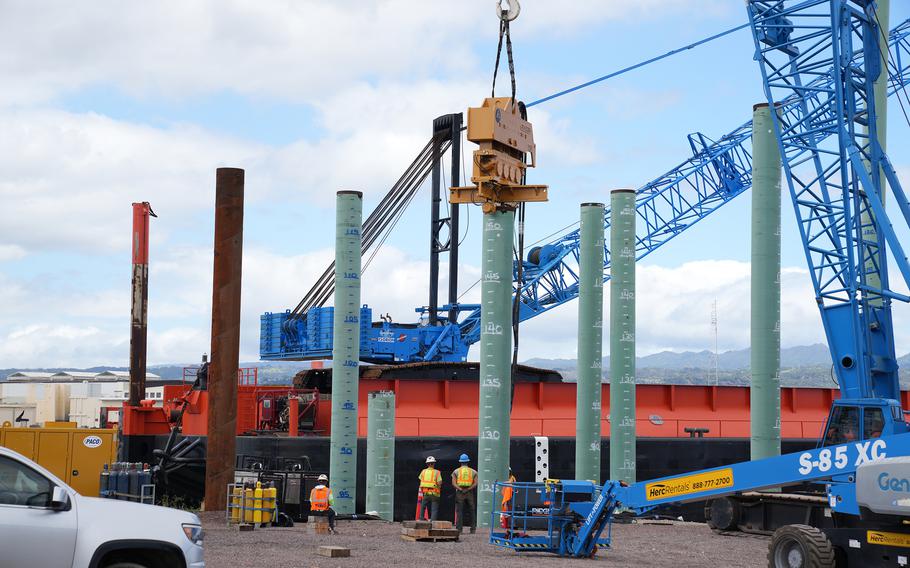
Three-foot diameter piles are driven in by a vibratory hammer, March 18, 2024, during construction of a dry dock at Pearl Harbor Naval Shipyard and Intermediate Maintenance Facility. (Joel Onemu/U.S. Navy)
The Navy is studying options for supplying its four public shipyards with electricity and potable water in the event of a power grid or utility outage that could last up to two weeks.
The Naval Facilities Engineering and Expeditionary Warfare Center last month awarded a $3.7 million contract for an electrical microgrid study, according to a news release Sept. 26.
The contract went to Jacobs Engineering CH2M Hill/Clark Nexsen Energy Partners Joint Venture, which is expected to complete the study in about a year.
The contract expects proposals for ensuring up to 14 days of power and water for the shipyards during an outage, according to the release.
The study will look at Norfolk Naval Shipyard in Portsmouth, Va.; Pearl Harbor Naval Shipyard in Honolulu; Portsmouth Naval Shipyard in Kittery, Maine; and Puget Sound Naval Shipyard in Bremerton, Wash.
The study is part of the Navy’s ongoing Shipyard Infrastructure Optimization Program, which was established in 2018 and led by the engineering systems command.
The program tackles infrastructure deficiencies that hinder shipbuilding and maintenance capacity at the yards.
The aging shipyards were built in a bygone era of conventionally powered ships and are not configured to efficiently maintain and modernize nuclear-powered aircraft carriers and submarines, according to the Navy.
The optimization program to date has completed 30 projects costing $867 million, with another $6 billion of projects under contract, according to the Sept. 26 release.
The Navy is building a $3.4 billion submarine dry dock at Pearl Harbor and a $1.7 billion dry dock complex in Kittery.
The one-year study will consider the technical, economic and environmental feasibility of microgrids.
“This study is foundational to providing energy resilience at our naval shipyards,” Capt. Luke Greene, the optimization program’s manager, said in the news release.
“Off-grid survivability is critical to maintain the shipyards’ operations under adverse conditions and deliver ships and submarines back to the fleet on time,” he said.
The shipyards are currently capable of supplying backup power via generators and power plants, Greene wrote in an Oct. 17 email in response to written questions.
But those sources possess “limited capability to automatically and efficiently route power from distributed generation to the critical loads and then back to the normal configuration when grid power is restored,” he wrote.
“The brain of such a system will be a microgrid system,” he wrote.
Microgrid systems could be a combination of existing or new sources of energy.
“New sources of power may include solar photovoltaic, wind, biomass, ocean energy, small nuclear reactors, battery storage, pumped hydro storage, or thermal energy storage,” Greene wrote.
“Sources of potable water may include storage tanks, wells, or treatment plants that could desalinize surrounding water,” he wrote.
Power and water options for noncritical areas of the shipyards will not be considered in the study.
The decision to focus the study on options for a 14-day period of operation for a microgrid was driven by requirements by the federal government and Defense Department for energy conservation and sustainability, Greene wrote.
Recommendations from the study that receive Navy approval will be incorporated into the optimization program’s construction plans for each shipyard, he wrote.